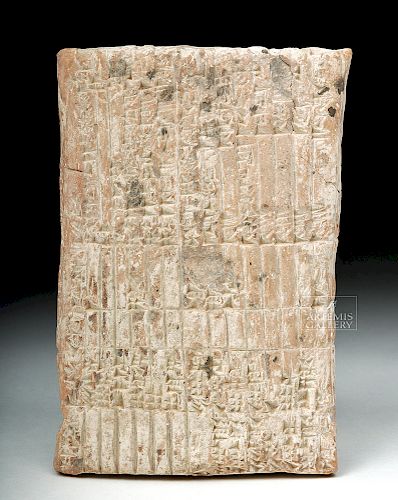Translated Babylonian Cuneiform Administrative Tablet
Lot 90
About Seller
Artemis Gallery
686 S Taylor Ave, Ste 106
Louisville, CO 80027
United States
Selling antiquities, ancient and ethnographic art online since 1993, Artemis Gallery specializes in Classical Antiquities (Egyptian, Greek, Roman, Near Eastern), Asian, Pre-Columbian, African / Tribal / Oceanographic art. Our extensive inventory includes pottery, stone, metal, wood, glass and textil...Read more
Categories
Estimate:
$4,000 - $6,000
Absentee vs Live bid
Two ways to bid:
- Leave a max absentee bid and the platform will bid on your behalf up to your maximum bid during the live auction.
- Bid live during the auction and your bids will be submitted real-time to the auctioneer.
Bid Increments
| Price | Bid Increment |
|---|---|
| $0 | $25 |
| $300 | $50 |
| $1,000 | $100 |
| $2,000 | $250 |
| $5,000 | $500 |
| $10,000 | $1,000 |
| $20,000 | $2,500 |
| $50,000 | $5,000 |
| $100,000 | $10,000 |
| $200,000 | $20,000 |
About Auction
By Artemis Gallery
May 10, 2018
Set Reminder
2018-05-10 10:00:00
2018-05-10 10:00:00
America/New_York
Bidsquare
Bidsquare : Fine Ethnographic / Asian / Ancient Art
https://www.bidsquare.com/auctions/artemis-gallery/fine-ethnographic-asian-ancient-art-3213
Featuring antiquities from around the world including Pre-Columbian, Tribal, Classical, Asian, so much more! Artemis Gallery info@artemisgallery.com
Featuring antiquities from around the world including Pre-Columbian, Tribal, Classical, Asian, so much more! Artemis Gallery info@artemisgallery.com
- Lot Description
Ancient Near East, Babylon, Middle Babylonian Period, 14th year of the reign of King Kadashman-Turgu, ca. 1268 BCE. An enormous and incredibly-detailed administrative tablet, formed from pressing an sharpened reed tool into bricks of soft terracotta and then firing in a kiln. The rectangular tablet contains thirty-three distinct lines of intricate impressed Cuneiform text used as a ledger to monitor and measure the movement, usage, and distribution of certain agricultural goods. Rounded along the top and bottom and planar along the sides, this is a fantastic example of some of the earliest-known instances of accounting and product allocation. Size: 5.25" W x 3.375" H (13.3 cm x 8.6 cm).
In summary, the translation of this tablet notates the harvest revenues from the town of Irre in the 14th year of the reign of King Kadashman-Turgu. Listed agricultural products include the quantitative distribution of such materials as wheat, barley, and emmer - a wheat strain native to areas which surround the Caspian Sea thought to be one of the first bread wheat strains widely cultivated for mass production. The tablet also includes the amount of each material which was deducted from the total shipment for taxation purposes.
Cuneiform script is one of the oldest known writing systems in the world, made using a reed as a stylus and scratching wedge-shaped marks onto clay tablets. Early cuneiform was pictographic, but in the 3rd millennium BCE it shifted to the more abstract form you see here. These cuneiform tablets are some of the roughly 2 million known from this culture; of these, between 30,000 and 100,000 have been translated. The earliest translations came in 1836 from the work of French scholar Eugene Burnouf and by the 1850s multiple scholars were able to produce similar translations, meaning the language had been deciphered.
Provenance: private East Coast, USA collection
All items legal to buy/sell under U.S. Statute covering cultural patrimony Code 2600, CHAPTER 14, and are guaranteed to be as described or your money back.
A Certificate of Authenticity will accompany all winning bids.
We ship worldwide and handle all shipping in-house for your convenience.
#132507Portion of top section reattached with small chips along break lines. Small loss to bottom corner with stable hairline fissure above. Surface wear commensurate with age, fading to some Cuneiform text, with small nicks and chips around interior and peripheries, and some minor discoloration, otherwise very good. Light earthen deposits throughout.Condition
- Shipping Info
-
All shipping is handled in-house for your convenience. Your invoice from Artemis Gallery will include shipping calculation instructions. If in doubt, please inquire BEFORE bidding for estimated shipping costs for individual items.
-
- Buyer's Premium



 EUR
EUR CAD
CAD AUD
AUD GBP
GBP MXN
MXN HKD
HKD CNY
CNY MYR
MYR SEK
SEK SGD
SGD CHF
CHF THB
THB















